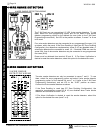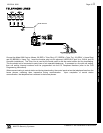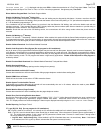
L NAPCO Security Systems
Freedom F-64 Installation Instructions
WI1501A 9/06
Page 21
Default Code of "456789". Press RESET to exit the EZ Program Mode. Access the address location "Cold Start" (see the Programming
Instructions WI1502), then press the U button.
Data Format
Ask the central station which of these formats to use:
Two-Digit or 4/2 Format - Some central-station receivers require that a four-digit Account Code followed by a two-digit Alarm Code be sent in
each report. Example: In a certain installation, the Alarm Subscriber Number is "1234"; a burglary alarm occurs on Zone 1. The Alarm Code for
Zone 1 is "3". The communicator will send "1234 31" (Account Number 1234; Alarm, Zone 1).
1400Hz Handshake/Kissoff - 1400Hz Handshake overrides 2300Hz Handshake if both are selected.
2300Hz Handshake/Kissoff - Used with the following receiver formats: Radionics, DCI & Franklin Slow; Radionics Fast.
Zone Number on Pulse Alarm. If selected, an Alarm Code need not be programmed (the zone number will replace the Alarm Code), however
codes for restore, trouble, etc. are still required. Thus, in the foregoing example, if "E" is the designated Restore Code, and Zone 24 trips and is
restored, the communicator will send "1234 24" (Account No. 1234; Alarm, Zone 24) followed by "1234 E4" (Account Number 1234; Zone 24
Restored).
Single-Digit (Pulse Only) Format. The single digit sent for a particular digit of the zone number.
Sum-Check Format. Sum Check is a sophisticated data format used to enhance the speed and check the accuracy of the received transmission.
This format should be preferred whenever the central station is capable of receiving it. After transmitting the Subscriber Identification Number and
the Alarm Code, the communicator sends a verifying digit that is the sum of both. The receiver compares the verifying digit with the sum of the
other numbers to check transmission accuracy. This feature eleiminates the need to repeat data and saves time.
3/1 with Extended Restores. Some receivers require a three-digit Account Code followed by a single-digit Alarm Code. Example: In another
installation, the Alarm Subscriber Number is "123"; an alarm on Zone 1 is restored. The Restore Code for Zone 1 is "E,1". The communicator will
send "123 E" (Account No. 123 Restored); followed by "EEE 1" (Restored, Zone 1).
Modem Formats. Modem formats (SIA, Point ID) are preset and automatic but require a Type for each zone. Program Zone Type as follows:
Fire* = "1"; Panic = "2"; Burglary = "3"; Holdup = "4"; Gas Alarm = "7"; Heat Alarm = "8"; Auxiliary Alarm = "A" (F-64PROG programmer displays
"0"); 24-Hour Aux. Alarm = "B".
Pager Formats. The control panel has provisions for dialing a pager phone number. The panel will wait for ringing, wait for silence, then send its
data. Caution: Because there is no handshake/kissoff, this feature should only be used for Double Reporting; it may not be used for Backup
Reporting. Only one report is sent for any call. Pager digits are limited to "0" through "9". Digits represented by "A" through "F" will be converted
to "0"s for transmission purposes. Pager formats are 10 digits, arranged as illustrated by the following examples.
Alarms, restores, etc. are transmitted in a 3-2-4 arrangement representing Report Code, Descriptor and Account Number.
Example 1. Burglary, Zone 22 (Report Code = "3").
Transmits: 003 22 1234, where
003 = Report Code (always two zeros + programmable Report-Code digit, 0–9);
22 = Descriptor (2-digit descriptor, zone number: 01–64);
1234 = Account Number (4 digits, programmable).
Openings, closings, etc. are transmitted in a similar arrangement
Example 2. Closing, User 12 (Closing Code = "8")
Transmits: 008 12 1234, where
008 = Report Code (always two zeros + programmable Opening/Closing digit, 0–9)
12 = Descriptor (2-digit descriptor (user number: 01–32);
1234 = Account Number (4 digits, programmable).
Keypad/Touchpad Report Codes and System Report Codes are transmitted in the same format.
Compatible Receivers. The following receivers are compatible with the F-64 :
FBI CP220. Formats: Ademco Slow; Silent Knight Slow; Silent Knight Fast; DCI; Franklin Slow; SIA; Radionics Slow; Radionics Fast; Universal
High Speed.
Ademco 685. Formats: Ademco Slow; Silent Knight Slow; Silent Knight Fast; DCI; Franklin Slow; Radionics Slow; Radionics Fast; Universal High
Speed; Ademco Point ID.
Radionics 6500. Formats: Ademco Slow; Silent Knight Slow; Silent Knight Fast; DCI; Franklin Slow; Radionics Slow; Radionics Fast; Universal
High Speed.
Osborne-Hoffman Quickalert. Formats: Ademco Slow; Silent Knight Slow; Silent Knight Fast; DCI; Franklin Slow; SIA; Radionics Slow;
Universal High Speed; Ademco Point ID.
Silent Knight 9000. Formats: Ademco Slow; Silent Knight Slow; Silent Knight Fast; DCI; Franklin Slow; Radionics Slow; Radionics Fast;
Universal High Speed; SIA.
Date/Time
A Date/Time can be set in the Touchpad Menu Mode or the Quickloader program. "Enable Keypad Set Date/Time Message" will
automatically request the date and time at the Touchpad after extended power failures (if enabled).
Glossary


















